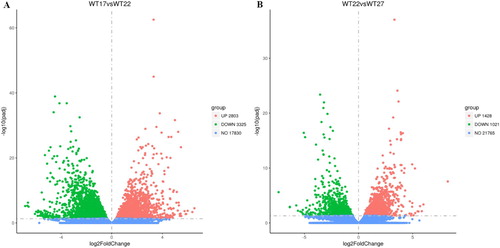Figures & data
Figure 1. Volcano plot. The number of differentially expressed genes of wide-type roots at 17°C vs 22°C(A) and 22°C vs 27°C (B). Red means up-regulated genes, green means down-regulated genes, and blue means no significant genes.

Register now or learn more
Open access
Figure 1. Volcano plot. The number of differentially expressed genes of wide-type roots at 17°C vs 22°C(A) and 22°C vs 27°C (B). Red means up-regulated genes, green means down-regulated genes, and blue means no significant genes.

People also read lists articles that other readers of this article have read.
Recommended articles lists articles that we recommend and is powered by our AI driven recommendation engine.
Cited by lists all citing articles based on Crossref citations.
Articles with the Crossref icon will open in a new tab.